Mechanics of Khans of Tarkir
The Khans of Tarkir set introduces us to Sarkhan Vol's home world Tarkir, where five clans vie for supremacy. Each clan is aligned with three colors of magic and led by a powerful khan. Cards closely associated with a clan, including all cards with the clan's signature mechanic or ability, are marked with a clan icon in their text boxes.
Table of Contents
Outlast
Prowess
Delve
Raid
Ferocious
Morph
Modal Spells and Abilities

Outlast
The Abzan (the white-black-green clan) signature ability is outlast. Outlast is an activated ability.
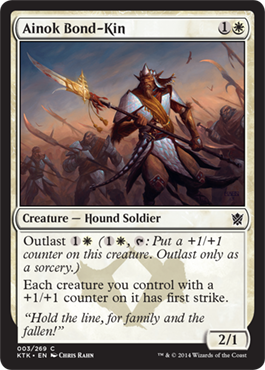
The Abzan are all about endurance, and nothing prepares you for a long game better than growing your creatures over time. You can activate an outlast ability during your main phase if the stack is empty—otherwise known as any time you could cast a sorcery. Outlast abilities include the tap symbol ( ), so a creature's outlast ability can't be activated unless that creature has been under your control continuously since the start of the turn (unless it has haste). When an outlast ability resolves, put a +1/+1 counter on the creature. Several other cards in the set give bonuses to creatures with +1/+1 counters. This works great with outlast, although any +1/+1 counter will count.
), so a creature's outlast ability can't be activated unless that creature has been under your control continuously since the start of the turn (unless it has haste). When an outlast ability resolves, put a +1/+1 counter on the creature. Several other cards in the set give bonuses to creatures with +1/+1 counters. This works great with outlast, although any +1/+1 counter will count.

Prowess
The Jeskai (the blue-red-white clan) signature ability is prowess. Prowess is a triggered ability.
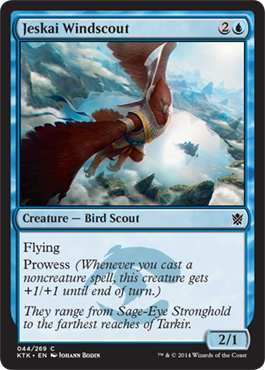
The Jeskai specialize in cunning and attacking in unexpected ways. Prowess triggers whenever you cast a noncreature spell. When prowess resolves, the creature gets +1/+1 until end of turn. And any noncreature spell will work: artifact spells, enchantment spells...even Planeswalker spells!
Creature spells won't cause prowess to trigger, even if those spells have other card types, such as an artifact creature spell. Instants work particularly well, as they become combat tricks that boost your attacking or blocking creatures in addition to whatever they normally do.
When prowess triggers, it goes on the stack on top of the spell that caused it to trigger, meaning it will resolve first. Once prowess has triggered, it doesn't matter what happens to the noncreature spell. If it gets countered, prowess will still resolve, as long as the creature with prowess is still around.

Delve
The Sultai (the black-green-blue clan) signature ability is delve, a returning ability from the Future Sight set.
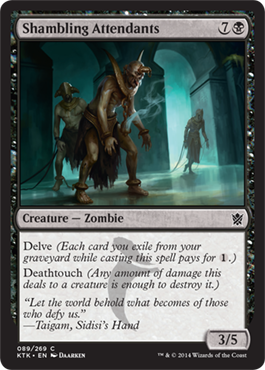
Spells with delve are very powerful, but usually have a high mana cost. Fortunately, you don't need to pay all of it with mana. The Sultai's ruthlessness leads them to use every resource at their disposal, even the dead. As you're paying for the spell, you can exile cards from your graveyard. Each card you exile this way pays for  . So, if you're casting Shambling Attendants, you can pay
. So, if you're casting Shambling Attendants, you can pay 
 . You can also exile four cards from your graveyard and pay
. You can also exile four cards from your graveyard and pay 
 , which is a pretty good deal. If you have seven cards in your graveyard, you can exile them and get Shambling Attendants for only
, which is a pretty good deal. If you have seven cards in your graveyard, you can exile them and get Shambling Attendants for only  !
!
Delve can't pay for any colored mana in the spell's mana cost. Also, you can't exile more cards than the amount of colorless mana in the mana cost. So you couldn't exile more than seven cards while casting Shambling Attendants, even if for some reason you wanted to. If the spell with delve is countered, you don't get those cards back from exile, just as you don't get a refund on your mana.

Raid
The Mardu (the red-white-black clan) signature mechanic is raid. Raid is an ability word, so it has no rules meaning, but it's used to highlight abilities that care about whether you've attacked with a creature during the turn.
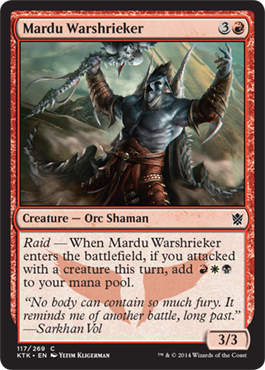
Speed defines the Mardu's every action, so if you want to win with them, keep on the move and attack! Each raid ability is different, so read each carefully to determine what it does. Raid abilities care only that you've attacked with a creature. It doesn't matter how many creatures you attacked with, and it doesn't matter if those creatures attacked an opponent or an opposing Planeswalker. Raid abilities won't mean much on your opponent's turn or before your combat phase, but your aggression will be well-rewarded.

Ferocious
The Temur (the green-blue-red clan) signature mechanic is ferocious. Like raid, ferocious is an ability word. It has no rules meaning, but is used to highlight abilities that care about you controlling a creature with power 4 or greater.
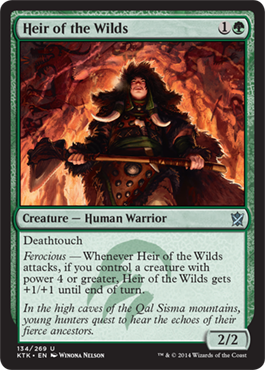
The Temur rely on savagery to survive Tarkir's brutal landscape. Each ferocious ability is different, but they all rely in some way on controlling a creature with power 4 or greater. It doesn't matter how many creatures with power 4 or greater you control. For example, whenever Heir of the Wilds attacks, its ability checks if you control a creature with power 4 or greater. If you do, it will trigger and go on the stack. Even if you control ten such creatures, the ability will trigger only once. As that ability tries to resolve, it'll check again. If you still control a creature with power 4 or greater, the ability will resolve and give Heir of the Wilds +1/+1 until end of turn.
Instants and sorceries with ferocious abilities check if you control a creature with power 4 or greater as they resolve. If the ferocious ability says "instead," that effect will replace some or all of the normal effect of that instant or sorcery. If it doesn't say "instead," the effect of the ferocious ability happens in addition to the spell's normal effect.

Morph
Each of the five clans uses deception to outmaneuver its rivals. Morph is a returning mechanic that lets you cast spells as face-down creatures, disguising their true identity until you turn them face up.
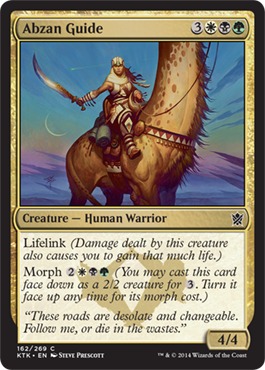
You can cast a creature spell with morph face down whenever you normally could cast that card. Usually, this means during your main phase when the stack is empty. To do this, turn the card face down so no other player can see what it is. A face-down creature spell is a 2/2 colorless creature spell with no name, no creature types, no abilities, and no mana cost. Instead of paying its mana cost (which it doesn't have), you pay  . If the spell resolves, put the card face-down onto the battlefield, where it will have those same characteristics instead of its normal ones. You can always cast a creature card with morph face up by paying its mana cost as normal.
. If the spell resolves, put the card face-down onto the battlefield, where it will have those same characteristics instead of its normal ones. You can always cast a creature card with morph face up by paying its mana cost as normal.
You may find one of these overlay cards in a Khans of Tarkir booster pack:
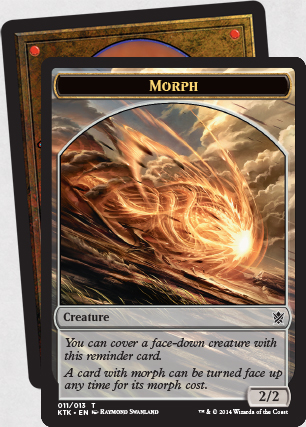
You can put this overlay card on top of one of your face-down creatures while it's on the battlefield. It's just a sweet-looking reminder; you don't have to use it if you don't want to. It doesn't change how face-down creatures function.
Face-down creatures are creatures in every way. They can attack and block, and spells and abilities that target creatures can target them. They can be enchanted by Auras and equipped by Equipment. You can look at your face-down creatures at any time. You can't look at your opponent's face down creatures...that is, unless a card says you can.
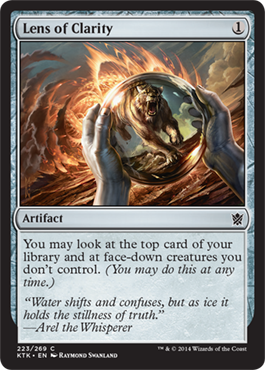
Any time you have priority, you can turn the face-down creature face up by paying its morph cost. This causes the creature to immediately turn face up so it has its normal characteristics. This is called a special action because it doesn't use the stack and can't be responded to. It just happens. So, say you control a face-down Abzan Guide. I have a Shock in hand, and I'd really like to destroy your creature. If I cast Shock targeting your face-down creature, you can pay 


 to turn it face up. Shock will end up dealing 2 to your Abzan Guide, but now it has 4 toughness. Bummer. Well, for me. You're probably pretty happy.
to turn it face up. Shock will end up dealing 2 to your Abzan Guide, but now it has 4 toughness. Bummer. Well, for me. You're probably pretty happy.
But let's say you initiate the action by turning Abzan Guide face up first. Unfortunately for me, this doesn't use the stack, so by the time I can cast Shock, Abzan Guide and its 4 toughness are already face up. Bummer again. You're probably giggling at this point. Morph is pretty powerful.
If the face-down creature has any Auras or Equipment attached to it, those remain attached to the face-up creature. The same is true for any counters on the creature. It's not a new creature, and it doesn't enter the battlefield just by turning face up. If a creature with morph is on the battlefield face up, you can't turn it face down unless a card tells you to. (No cards in Khans of Tarkir do this, but a few older cards do.)
A few creatures have abilities that trigger when they're turned face up.
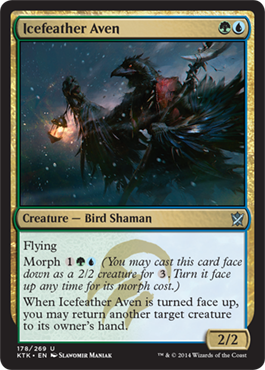
If you control more than one face-down creature, you must make sure they can easily be differentiated from one another. You're not allowed to mix them up to confuse your opponent. The order they entered the battlefield should be clear. You can use dice or other markers to do this, or you can clearly place them in order on the battlefield. For example, if you attacked with one of your three face-down creatures last turn, it should be clear to all players which creature it was that attacked.
If a face-down creature leaves the battlefield, reveal it to all players to show them it was a creature card with morph. Do this no matter where the card is going—back to your hand, to exile, to your graveyard, or elsewhere. You also have to reveal your face-down creatures if the game ends or if you leave a multiplayer game. This is especially important in tournament games.

Modal Spells and Abilities
Khans of Tarkir introduces a snazzy new way to display modal spells and abilities. Previously, you'd know a spell or ability if it said "Choose one—" or similar. From now on, your options will be conveniently displayed in a bulleted list.
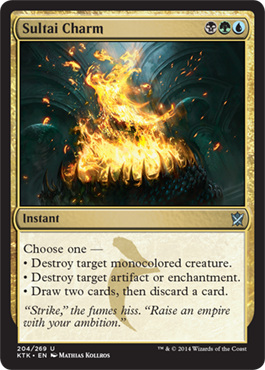
Nothing about how these cards work is changing. You still choose which mode you are using as you cast the spell or activate the ability. If the spell or ability is copied, the copy must use the same mode. And once the spell is cast, you can't change which mode you're using.
Have fun battling on Tarkir with a mighty clan by your side!

